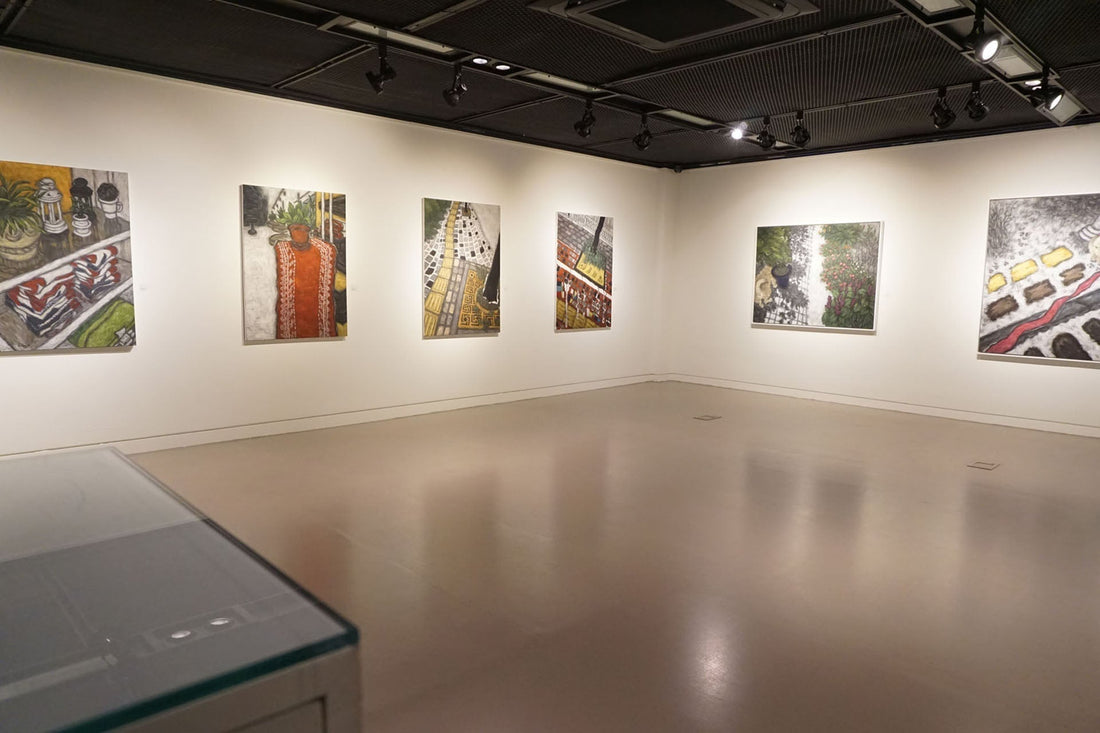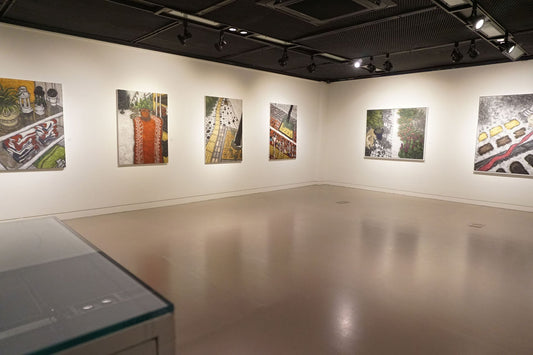
Shallow Art vs. Deep Art: On the Depth and Quality of Artistic Work
Share
Why Do We Keep Creating Art?
Last time, we pondered on what makes us, artists, continue to work in art; this time, let’s have a conversation on what truly good works are and what art with depth is.
As we’ve discussed last time, if money is important, do we, as artists, only need to paint and live on works consumers buy to sustain our artistic life? If the definition is simply that ‘as long as artworks are being sold easily’, it feels rather easy to me.
The Allure and Limits of Commercial Art
The Allure and Limits of Commercial Art
Looking at works that sell well online, you can find a formula. That is also the case in the works hung for interior decoration of model houses in the US. The works seem to mimic modern art, but they are moderately modern, moderately pretty, yet weightless. There are no traces of the artist's sweat and tears, no soul that can be felt.
If you live by mass-producing such works, making a living wouldn’t be a great issue. Indeed, an artist I know has become very well-off by selling such paintings online. However, we, artists, often go down a path where we struggle to let go of our own stubbornness.
‘I will create artworks unique to myself.’
People rate themselves. Those who are determined to become so-called successful artists would not make commitments to die as painters who paint interior accessories or artists who produce paintings to order.
They dream of at least Picasso, Mark Rothko, or David Hockney. They are all masters who have perfected their own world, their own style, so future generations of artists ponder how they can create a world as deep as the great artists.
What is Depth in Art?
Then, what distinguishes deep art from shallow art? The issue of 'depth' is so profound to artists that the German novelist Patrick Süskind talked about it in his book.
In his book, The Compulsion to Death (Der Zwang zur Tiefe), there is one woman painter. Despite being a promising young artist, she cannot paint after a famous critic criticizes her artworks as lacking depth. After suspecting that her own work lacks depth, even her daily life collapses, to the extent that she leaves feces and urines in the room. In the end, she chooses a tragic ending of giving up on herself.
It is also a bitter anecdote that shows just how much artists are being forced to add depth to their work.
Why Criticism Hurts So Much?
Yet, was the critic's critique really that important? To the extent that you would change it with your own life.
Artists usually think of themselves and their work are one entity. Which means Artists often don’t separate their work from themselves. A critique of their art feels like a critique of their identity.
But it’s not just artists. Everyone, at some point, struggles with self-worth.How many would be able to live a life completely separate from what they love to do? To that extent, because one’s art is immersed in his or her life, even the evaluation of the work seems to be valued as an evaluation of oneself.
Then, what distinguishes deep art from shallow art?
Everyone, not just artists, evaluates themselves at least once. A social term that calls this is self-esteem. Although we think that the person who knows us best is ourselves, we are easily hurt by others’ assessments of us. If someone told me, ‘You’re so pushover’, I would be so angry even after I get home because that means I deserve to be ignored by others
Deep Roots, Steady Trees
Rooted in Struggle: The Truth About Meaningful Art
There is a phrase in Korean classics that says,
“A tree with deep roots is not swayed by the wind.”
What it says is that a tree with its roots deep in the ground is not shaken by a trivial wind. That is, a person with a strong sense of self is not easily shaken by external shocks.
The root is the artist, and the tree is the artwork that blooms in reliance on the roots.
The more you want to create magnificent work, the stronger the roots you need. By laying the groundwork, by reinforcing the foundation.
The Process of Making Deep Arts
Creating artwork with depth is the same process as creating a strong living organism. The process of a small tree becoming a big old tree is never easy. It must withstand the rain and wind, endure the cold, take root into the cold ground—as such, sustaining life is truly challenging from the beginning. That is why life is hard work, art is hard work.
We feel art is difficult because we are too hasty. We want to see the results quickly but things don’t work out as intended. We hope our work to rise in popularity quickly, allowing us to be famous, bringing in fortunes and fame—however, this one seems too slow.
The laws of time seem to apply equally to the world of nature or the world of art. Everything needs time. Trees need time to take root in the ground, and artists must endure difficult times.
Fighting Through the Fog
For artists, the challenging years are not necessarily limited to economic difficulties. Often, it’s about internal struggle—mental conflict, self-doubt. Conflicts of mind and fighting with oneself are the more arduous process.
Sometimes it feels like standing in the middle of a boundless sea. We can’t identify the east, west, north, and south, don’t know what or where to start. So we go to the studio, draw one line today and go home. Tomorrow, we paint a dot and go home. Art is like a cloud that you can’t catch no matter how many days or months you repeat such meaningless actions. There is no inspiration; my hands seem too inept. Nevertheless, we do not let go of the brushes to shape what is faintly looming in the mind.
The Temptation to Mimic
Anyone who tries to create something all goes through this process. This is a fight against vagueness. I hate this feeling of uncertainty so much that I often want to compromise with the world.
This is the moment when many artists feel tempted to copy others.
The greed to achieve great success quickly precedes so much—leading to mimicking the cool artworks out in the world before discovering oneself.
Action painting by Jackson Pollock, unrestricted graffiti by Basquiat.
These names are known even by people outside the art world. It’s easy to imitate them—but dangerous to confuse imitation with identity.
They lived their own lives. You must live yours. —this is the same for artworks.
Ironically, if you mimic them too closely, the world won’t respect it. The world might respond with something sarcastic, like,
‘Yes, that’s Basquiat. So you are Basquiat reincarnated?’
Since I have been through that process, I can understand what the artist was thinking as he or she was imitating Basquiat's work. Landscape painting is boring, still life painting is not exciting, and portrait painting is just mediocre. Those seem to be old-fashioned paintings, and the artist wanted to try something different, right?
But, listen, how far down have you dug into landscape painting? If a landscape painting is a cliché, there is no reason why Gogh's Wheat Field with Cypresses ' should still be loved. What is important is not what you draw, but how much you can express your own touch and your own soul inside the work.
The Long Road to Completion
I believe that anyone who wants to become an artist must patiently endure the hours of wandering while holding onto one’s paintings of unknown directions. One purported to draw a tree, but plastic is drawn, you erase and recolor all the drawings you’ve drawn so far, and you want to tear it up but somehow save it. To others, the work looks like it was painted in one day, but it was actually painted over two months.
And there is a sense of accomplishment that arises after enduring all those times. Just like drinking water after agonizing work is delicious. What is interesting is that the audience notices this in the work.
How much the artist struggled while holding onto the paper, and how deeply the canvas and the artist worked while forming a deep communion.
The True Meaning of Depth
If you can't stand these, do not be offended by critics calling your work shallow art.
Creating art as such is a process of nurturing oneself, a process of becoming the creator of a work. The tragedy of artists under the pressure to depth does not stem from an actual lack of the work’s depth but from the failure to define oneself.
Just because you haven’t become the person you want to be at this moment, that the depth has not been achieved, do not be too harsh on yourself. And give yourself more time. We are all imperfect and on a journey to get to ‘the place’.
And all the artists in this process are magnificent people because those endured uncertainty without being consumed by fear because we haven’t given up on our own unique work yet, because we haven’t given up on life yet.
Thank you for reading
Thanks for reading Christine’s Article
Subscribe for free to receive new posts
and support my work.
I want to chime in and say thank you to all the new subscribers here
and encourage all of my free subscribers to please consider supporting my work here
on christinebae.com with a paid subscription.
For as little as $5 a month or $50 a year, you can help sustain my work here.
Other ways to support my work here include include donating to my paypal account
Author: Christine Bae
Who is Christine Bae?
I’ve been working as a full-time artist for seven years now.
As a professional painter with a passion for collecting great artwork, I’m excited to connect with people who share that same appreciation.
I don’t sell originals online, but I do offer art prints as a way to share my work more widely.
↓↓↓↓↓
[See My Art Prints]
[Browse Original Works]
[Read the Artist’s Story]
[Support the Artist]
Originally published at Christinebae.com
This article was written by Christine Bae.
Unauthorized reproduction is prohibited. All copyrights belong to Christine Bae.
© Christine Bae All rights reserved.




